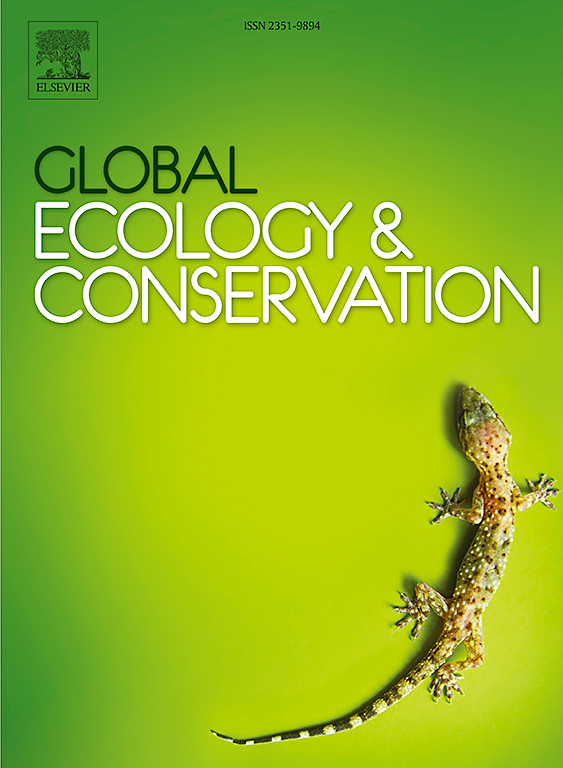比较人工和真空吸尘器在不同生境中使用温克勒提取器取样亚热带蚂蚁的效率
IF 3.4
2区 环境科学与生态学
Q1 BIODIVERSITY CONSERVATION
引用次数: 0
摘要
采样工作和方法是生态学和生物多样性研究的基础。在过去的40年里,温克勒提取器越来越多地用于对凋落叶和表土节肢动物进行取样。然而,它的使用受到各种因素的限制,如凋落物数量、环境湿度水平或昆虫组成,因此,可能会限制我们对取样物种群落的理解。人工采集需要人工收集地表凋落物和松散土壤,这可能被认为是耗时的,容易产生风险,并且可能不是采样节肢动物的最佳选择。因此,通过机械吸入改进手动进气方法可能会潜在地解决这些限制。本研究提出了使用温克勒提取器处理蚂蚁之前的两种现场收集方法的比较。在此,我们评估了人工和真空吸尘器在林地、草地和荒地三种栖息地的吸入量的效率和互补性,以测量蚂蚁的多样性(α和β)、丰度和丰富度。我们假设,在蚂蚁丰度、物种丰富度和多样性方面,使用真空吸尘器的采样可以提供更全面的采样,同时在草原和荒地栖息地与人工采样相比更具时间效率。结果表明,在草地和荒地生境中,吸尘吸尘对蚁群丰度的影响明显高于人工吸尘,但对蚁群物种丰富度和多样性的影响较小。在林地内,不同指标间无显著差异。然而,就实用性而言,真空吸尘器的进气效率更高,大约比手动进气快36% %。综上所述,真空吸尘器吸入法只显示了实际的好处,但在这些栖息地取样的蚂蚁群落特征方面没有重大改善。本文章由计算机程序翻译,如有差异,请以英文原文为准。
Comparison of manual and vacuum cleaner intake approaches efficiency for sampling subtropical ants using Winkler extractor across different habitats
Sampling efforts and approaches represent the foundation of ecological and biodiversity studies. Winkler extractors have been increasingly used over the past 40 years to sample leaf litter and topsoil arthropods. Its use, however, is constrained by various factors, such as the litter quantity, environmental moisture levels or insect composition and, as such, may limit our understanding of the species communities sampled. The manual intake through hand sampling requiring the manual collection of surface litter and loose soil can be perceived as time-consuming, risk-prone and may be suboptimal to sample arthropods. Consequently, improving the manual intake method through mechanical suction could potentially address some of these limitations. This study presents a comparison of two field collection approaches prior to the treatment of ants using Winkler extractors. Here we evaluated the efficiency and complementarity of the manual and the vacuum cleaner intake across three habitats (woodland, grassland and wasteland) to measure the diversity (alpha and beta), abundance and richness of ants. We hypothesized that the use of vacuum cleaner intake offers a more comprehensive sampling in terms of ant abundance, species richness, and diversity, while being more time efficient in grasslands and wasteland habitats compared to the manual intake. Our results show that in grassland and wasteland habitats, vacuum cleaner intake presented an increase in ant abundance relative to the manual method but not in species richness nor diversity collected. Within woodlands no significant differences were observed for the different indices used. In terms of practicality, however, the vacuum cleaner intake showed greater efficiency, being about 36 % faster than manual intake. In summary, the vacuum cleaner intake method showed only practical benefits but no major improvements in the characterization of the ant communities sampled across these habitats.
求助全文
通过发布文献求助,成功后即可免费获取论文全文。
去求助
来源期刊

Global Ecology and Conservation
Agricultural and Biological Sciences-Ecology, Evolution, Behavior and Systematics
CiteScore
8.10
自引率
5.00%
发文量
346
审稿时长
83 days
期刊介绍:
Global Ecology and Conservation is a peer-reviewed, open-access journal covering all sub-disciplines of ecological and conservation science: from theory to practice, from molecules to ecosystems, from regional to global. The fields covered include: organismal, population, community, and ecosystem ecology; physiological, evolutionary, and behavioral ecology; and conservation science.
 求助内容:
求助内容: 应助结果提醒方式:
应助结果提醒方式:


